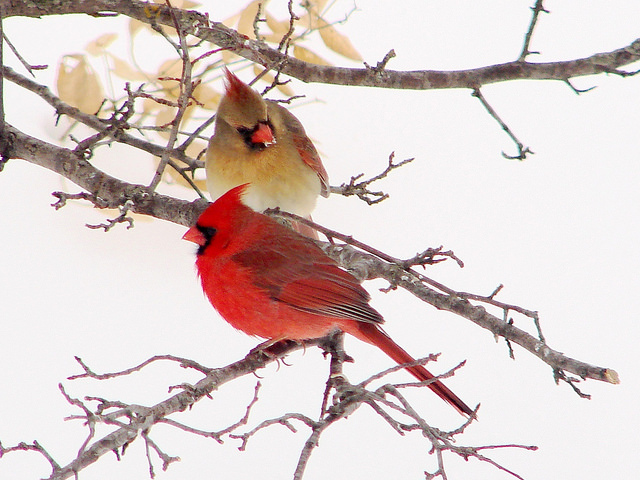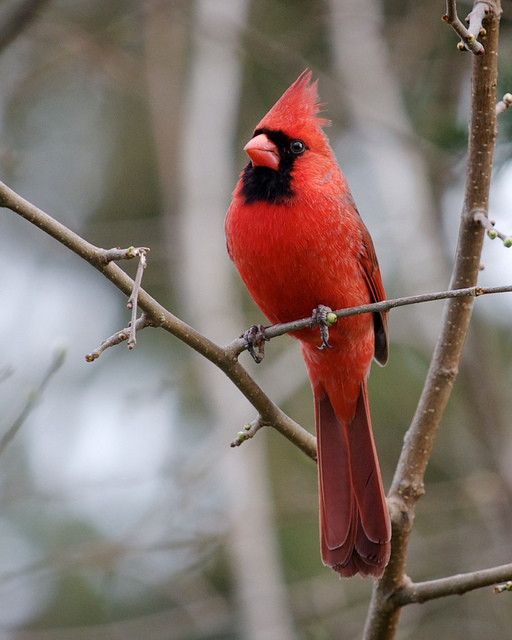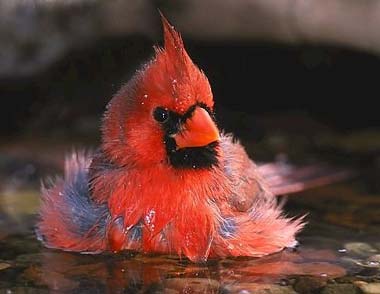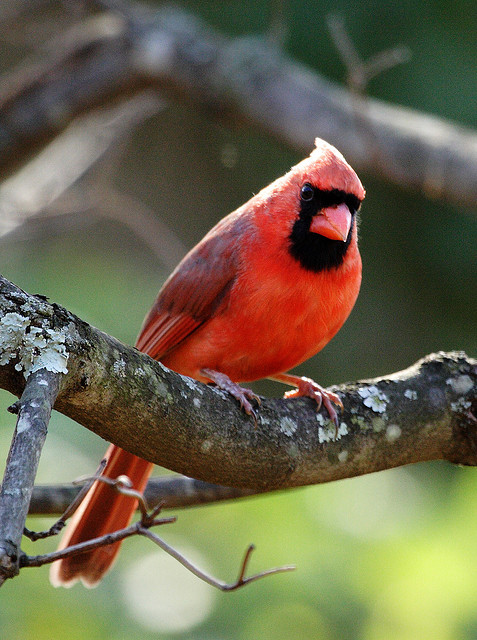Northern cardinal pair; photo by Ilona L on Flickr (noncommercial use permitted with attribution / share alike).
Northern Cardinal
North Carolina designated the northern cardinal (Cardinalis cardinalis) as official state bird in 1943. One of America's favorite backyard birds, cardinals are distinctive in appearance and song - known for their "cheer cheer cheer," "whit-chew whit-chew" and "purty purty purty" whistles.
Male cardinals are a brilliant scarlet red, females a buff brown with reddish wings; both have a jet-black mask, pronounced crest, and heavy bill. The cardinal sings nearly year-round, and the male aggressively defends his 4-acre territory (male cardinals have been seen attacking small red objects mistaken as other males).
Northern cardinals breed 2-3 times each season. The female builds the nest and tends the hatchlings for about 10 days while the male brings food. The male then takes over the care of this first brood while the female moves on to a new nest and lays a second clutch of eggs.
The cardinal is the state bird of 7 states: Illinois, Indiana, Kentucky, North Carolina, Ohio, Virginia, and West Virginia.
Northern Cardinal Bird Feeders
Interested in getting a bird feeder for northern cardinals? Check out our article: How to Choose Your Northern Cardinal Bird Feeders?
The following has been contributed by Donald Hobson | Freelance Writer
Are the Northern Cardinal an Endangered Species?
"Endangered species" appears to be a buzz term nowadays. It's almost impossible to watch the TV and not hear it. Without a doubt, we are on the brink of losing some of the most adorable and fascinating animal species that brighten our world. And as bird lovers, we have every reason to be concerned about our beloved friends.
The Northern Cardinal (scientific name - Cardinalis cardinalis) is one species that’s dear to most birders. Some studies show that this bird species is largely responsible for people's love for birdwatching.
For those who are unfamiliar with this bird, it’s a migratory bird found in North America. It’s mostly known for its conspicuous appearance and whistling. Our love for these birds leaves us to wonder whether or not they're safe.
Are the Northern Cardinal classified as an endangered species?
The good news is that the answer is no. Unlike the South American Yellow Cardinal, which belongs to the same order, the Northern Cardinal isn't on the list of endangered or threatened species. The International Union for Conservation of Nature (IUCN) lists this species as population stable (Least Concern) on its Red List.
On the flipside, these birds are increasing in number and spreading beyond their natural habitat. And this is primarily because of their adaptive capabilities and food availability, especially during winter.
As it stands, the chances of this beloved species being labeled as an endangered or threatened species is very low. The current Northern Cardinal global population will have to drop by at least 30% for the next ten years or across three generations before it can be listed as an endangered.
Despite their current status on the IUCN list, the Northern Cardinal are protected in the United States and Canada. Unlike in Europe were cardinals are kept in birdhouses, it’s illegal to possess cardinals in the US and Canada.
The Migratory Bird Treaty Act signed in 1918 prohibits the sale of this species as caged birds in the United States. Also, no one is allowed to hunt, purchase, keep, or kill Northern Cardinals in the US. Anyone found guilty of any of these acts could be sentenced to up to six months in prison or pay up to $15,000.
In Canada, the Northern Cardinal is protected by the Convention for the Protection of Migratory Birds. The law was established in 1917 and amended in 1994. People looking to keep Northern Cardinals may need to purchase a wildlife rehabilitator license from their respective states or municipalities to keep Northern Cardinals.
Conclusion
Like any other animal, the Northern Cardinal faces different harsh biological and man-made conditions. But they appear to be flourishing. So we get to see their red feathers and hear their sweet sounding whistles for many years to come. Great news for all bird lovers!





